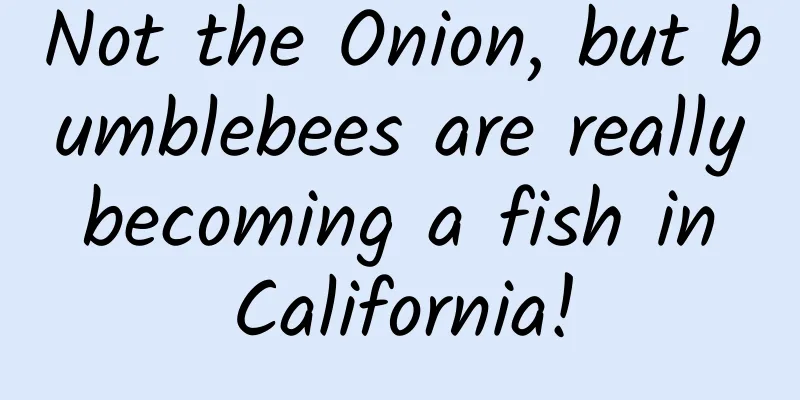Not the Onion, but bumblebees are really becoming a fish in California!

|
Starting from May 31 this year, four species of bumblebees in California, USA, officially became "fish". It sounds like something straight out of The Onion, but it's legally true—it was a California appeals court ruling made in an absurd move to save endangered bumblebees. Shouldn't bumblebees be protected? The story began in 2018. At that time, some animal protection organizations in California applied to include four species of bumblebees in the endangered species protection list. Unexpectedly, this later led to a lawsuit. A bumblebee called Bombus hypnorum (not one of the four protected species) | Malene Thyssen / Wikimedia Commons Bumblebees are big bees. They are cute with their furry, round bodies. Like other bees, bumblebees are also important pollinators in nature and play an important role in maintaining biodiversity. However, with the development of agriculture, their survival has become difficult. In order to prevent and control pests and increase crop yields, pesticides are widely used in agricultural production. When bees collect honey from plants contaminated with pesticides, they will also be attacked indiscriminately. On the other hand, modern agriculture is often monoculture, growing only one crop over a wide area. During the flowering period of these plants, a large number of bees gather rapidly and are extremely susceptible to infection by pathogens and parasites. At the same time, global climate change and habitat reduction have also dealt a severe blow to the survival of bees. According to data from the U.S. Fish and Wildlife Service, the number of bumblebees has dropped by nearly 90% in the past 20 years. A dead carpenter bee (Xylocopa pubescens) | Adityamadhav83 / Wikimedia Commons In October 2018, several animal protection organizations in California petitioned to add four species of bumblebees to the list of "endangered and threatened species." If included in this list, these bumblebees will be protected by the California Endangered Species Act (CESA). CESA stipulates that crimes involving endangered species will be punished by a fine of up to $50,000 and/or up to 1 year in prison. The California Fish and Game Commission, which is responsible for compiling the endangered species list, announced in June 2019 that the bumblebees were designated as candidate species. This means that the commission will provide them with temporary protection while the bumblebees are determined to be endangered, and any actions to kill the bumblebees or destroy their habitat are prohibited. The four species of bumblebees that became fish this time are: Figure 1: Bombus crotchii, Figure 2: Bombus occidentalis | USGS Bee Inventory and Monitoring Lab from Beltsville Picture 3 shows Bombus suckleyi|Hadel Go / American Museum of Natural History Figure 4 shows Bombus franklini|James P. Strange / USDA-ARS Pollinating Insect Research Unit This move was opposed by many agricultural interest groups. In September of the same year, these groups filed a lawsuit in the Sacramento County Superior Court in California, arguing that bumblebees should not be included in the list of endangered species. Who should be protected? The opposition from these agricultural groups may seem ruthless, but it is “reasonable and well-founded.” The California Endangered Species Act clearly states that the law protects birds, mammals, fish, amphibians, reptiles, and plants—insects, or invertebrates, are not among them. If you want bumblebees to be protected by this law, there is a way - make bumblebees fish. The California Endangered Species Act does not specify what a fish is, but the law is part of the California Fish and Game Code, which defines fish as mollusks, crustaceans, invertebrates, or amphibians. According to this definition, bumblebees, as insects, are invertebrates, so shouldn't they be considered a fish? Although fish are clearly vertebrates|Pixabay The court was not convinced by this explanation. In 2020, the Sacramento County Superior Court ruled that the definition of "fish includes invertebrates" in California's fishing and hunting regulations needs to be understood in context and should be limited to aquatic animals. The ruling at the time also believed that if bumblebees were listed as endangered species, it would likely be detrimental to farmers, who might refuse to place beehives on their land from then on. As a result, bumblebees were removed from the endangered species list and are no longer protected under the California Endangered Species Act. Make bumblebees fish The Fish and Game Commission and animal protection groups were dissatisfied with the ruling and appealed to the higher California Court of Appeal. This time, the judiciary has a different view. On May 31, 2022, the California Court of Appeal overturned its previous ruling, holding that the California Fish and Game Commission had the legal right to list bumblebees as a type of fish, making them protected under the California Endangered Species Act. The 35-page opinion discusses in detail what constitutes a fish under the law. "In our everyday parlance, fish are, of course, fish that live in water," Justice Ronald Robie explained. "However, if the legislature provides a technical definition for a term, we will interpret the term in accordance with the technical meaning. In performing this function, our task is to interpret the statute liberally to achieve its remedial purpose." In other words, for the purpose of conservation, the bumblebee becomes a fish. This snail, Monadenia setosa, has also become a fish | Len Mazur Moreover, this is not the first time that California has classified a land animal as a fish. As early as 1980, a snail called Monadenia setosa was added to the endangered species list as a fish. The current legal system in the United States includes case law, and precedent cases can be used as a reference for the judgment of later cases. The case of the snail 40 years ago also provided legal support for the judgment of the bumblebee this time. Why not modify the definition? This ridiculous lawsuit seems to have nothing to do with whether bumblebees are worthy of protection, but rather how to find loopholes in regulations and text. However, why not simply include invertebrates in the scope of protection? The California Fish and Game Commission actually tried this. The California Endangered Species Act was enacted in 1970, and the initially protected species categories only included birds, mammals, fish, amphibians and reptiles. In 1980, when the Fish and Game Commission added three butterflies and one snail to the endangered species list, it had already discovered that there was no place for invertebrates in the prescribed protection category. They applied to revise the category regulations, but ultimately failed. So the snail, Monadenia setosa, a mollusk and invertebrate, ended up on the list as a fish, as did two other endangered crustaceans: a freshwater shrimp and a crayfish that are endemic to California. The Shasta crayfish (Pacifastacus fortis) is a California-native crayfish that is currently a critically endangered species | Pacific Southwest Region US Fish and Wildlife Service In 1984, the California Endangered Species Act was amended to change the wording from "endangered and rare animals" to "endangered and threatened species" and to add plants to the category of protected species. Invertebrates were actually added initially, but were removed when the final revision was submitted. This is likely because the Fish and Game Commission already had the power to list invertebrates under the rules at the time—that is, to define them as fish. After all, in 1984, there were already three invertebrates among the 65 endangered and rare species on the list. Adding invertebrates to the list at this point did not increase the Commission's power. As a result, this "loophole" continues to this day, leading to the ruling that "bumblebees are fish." Western Bombus occidentalis | Stephen Ausmus / USDA ARS With the ruling, the four species of bumblebees have regained their status as endangered species—among them, the Franklin bumblebee (Bombus franklini), which has not been seen since 2006 and was suspected to be extinct. However, with this ruling, the bumblebees will be temporarily protected until the California Fish and Game Commission makes a final determination as endangered. The ruling also means that other insects facing endangered threats in the future may also be classified as fish and included in the endangered species list and receive corresponding protection. Although this sounds very strange, as Matthew Sanders, a lawyer at Stanford Law School who represented animal protection organizations and bumblebees in the lawsuit, said, for California bumblebees and other endangered invertebrates, "becoming fish" is a huge victory. Calendar Girl has something to say There are so many unique species living on our unique planet. However, as in this case, it is easier for us to overlook the inanimate plants and inconspicuous invertebrates, but they are an indispensable part of the ecosystem. As public awareness of environmental protection increases, these neglected animals are receiving more and more attention. I hope that one day, they will all receive the protection they deserve - in their own name. References [1] https://www.courts.ca.gov/opinions/documents/C093542.PDF [2] https://www.reuters.com/legal/litigation/bees-are-fish-under-calif-endangered-species-act-state-court-2022-06-01/ [3] https://www.sfchronicle.com/bayarea/article/Do-bumble-bees-count-as-fish-Here-s-why-a-17210861.php [4] https://www.reuters.com/legal/litigation/bees-are-fish-under-calif-endangered-species-act-state-court-2022-06-01/ [5] https://www.xerces.org/press/california-court-paves-way-for-protection-of-imperiled-bumble-bees [6] https://www.natlawreview.com/article/how-bumble-bees-became-fish-california-appellate-decision-illustrates-canons Compiled by: Hazel Editor: Mai Mai This article comes from the Species Calendar, welcome to forward If you need to reprint, please contact [email protected] |
>>: When I cut the fish, the flesh was blue. I asked: Can I still eat it? Is it delicious?
Recommend
The human brain has billions of neurons, so why does it only run at 10 bits per second?
Produced by: Science Popularization China Author:...
Cats have given so much for human health and scientific progress!
In the field of life science and medical research...
My family's jealousy was caused by the dog...
Being jealous is an innate emotion of human being...
8 Big Data Analysis Models - User Model (I)
A model refers to a formal expression of a practi...
A 9,000-word article that explains in detail the operation methods of private domain traffic in circle of friends!
In this article, the author analyzes the operatio...
Hu Shenzhi's Family Education Class: Solve all your children's problems and be a parent who is not confused
Hu Shenzhi's Family Education Course: Solve a...
Lemongrass, the lifelong enemy of some people
When it comes to ingredients that are “one man’s ...
Will charging a new energy vehicle to 70% full damage the battery?
Recently, CCTV News' special program focused ...
Apple Developer Affairs Contact Email List
[email protected] - The status of the app and i...
Leon Lederman: That weekend night, I figured out how to break parity.
On January 4, 1957, at a traditional Chinese lunc...
When is the best time to eat cookies and cakes to stabilize blood sugar?
I believe many people have this dilemma: they wan...
Apple releases iOS 15.0.2: finally fixes many iPhone issues!
[[428321]] After the release of iOS 15, various m...
Detailed explanation of common command lines for iOS development
For iOS development, we don’t use many command li...
Why is the public relations of that video website so "capricious"?
Yes, when you see this title, you must think of t...









